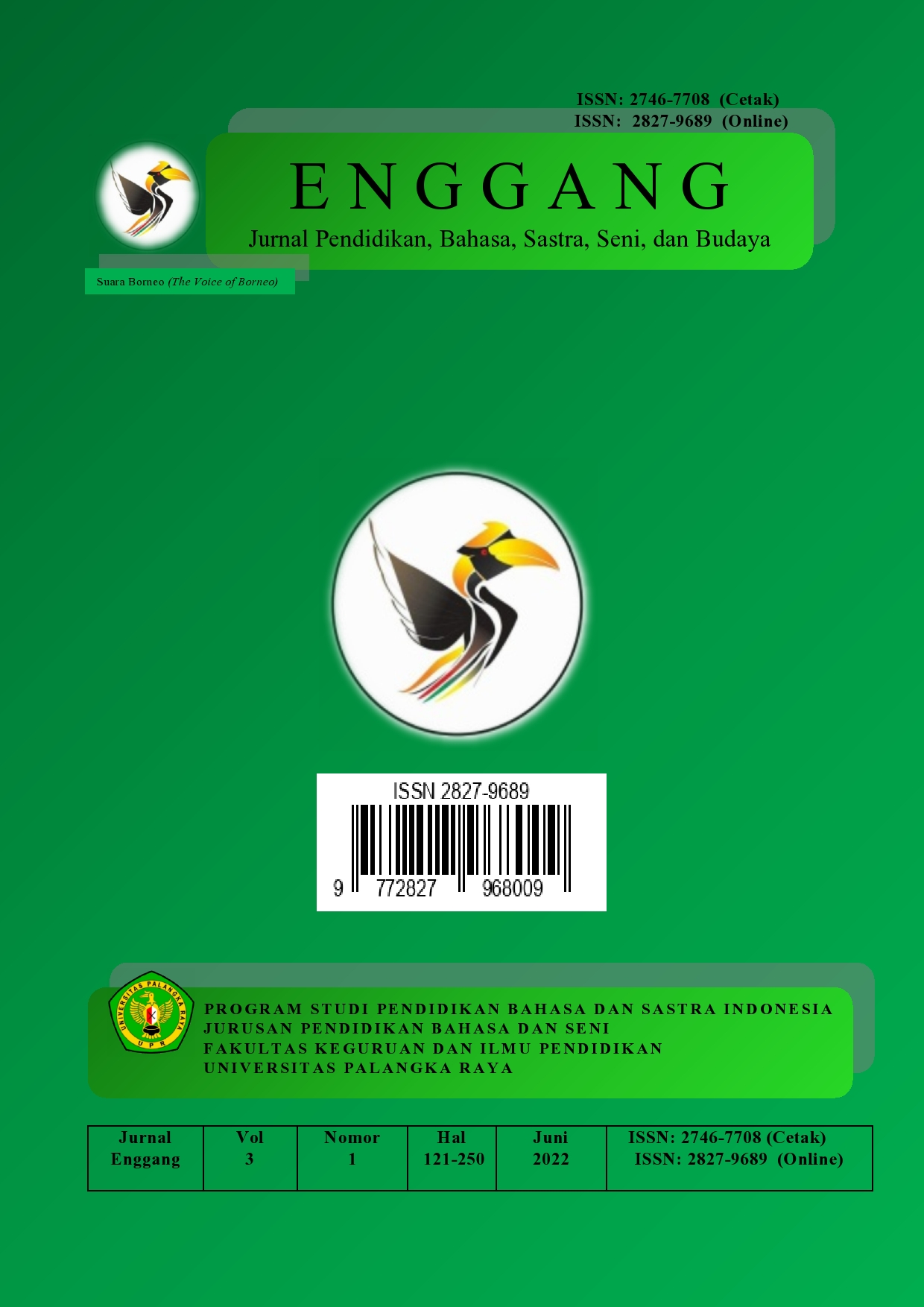Interpretasi Nilai Karakter Dalam Cerita Fabel Dayak Maanyan Kabupaten Barito Timur
DOI:
https://doi.org/10.37304/enggang.v4i2.14525Keywords:
Interpretation, Character Value, FableAbstract
The Dayak Maanyan Fable is an important part of their oral literature, different from the fables in other regions in Indonesia. This fable story has unique characteristics because it involves local animals. This study aims to interpret character values in five Dayak Maanyan Fable stories using descriptive qualitative methods and gadamer hermeneutics approaches. The stages involve interpretation, interpretive text, historical text, prejudice, data analysis, and prejudice. Through the Gadamer hermeneutics approach, Dayak Maanyan Fables from East Barito Regency revealed a number of significant character values. In the "Nalau Baya Wurung Sariak Fable," we see the clarity of moral and ethical values. This includes the desire to steal or cheat, honesty, self -control, forgiveness, mistakes, loyalty, acceptance, and power of music and singing as a means of transformation. In "Madituen, Rare'eh Baya Parang," we find lessons about greed, impatience, cooperation, fear, and responsibility for our actions. The "Indre Baya Wurung Angkaraei" fable discusses the values of honesty, arrogance, consequences of actions, forgiveness, and curses as natural punishment. "Manu Jumpun Baya Wu'ah" teaches about mutual respect, respecting the diversity of life, and the importance of friendship. Finally, in "Weruk Baya Warik," the value of cooperation, repentance, justice, quality friendship, and appreciation for the environment is highly emphasized. These fables reveal the depth of the Dayak Maanyan culture and philosophy and provide valuable moral lessons.
Downloads
References
Gadamer, H.-G. (2004). Kebenaran dan metode: Pengantar filsafat hermeneutika. Yogyakarta: Pustaka Pelajar.
Kau, S. A. (2019). Hermeneutika Gadamer dan relevansinya dengan tafsir. Journal IAIN Gorontalo, 109-123.
Malawat, I. (2022). Nilai pendidikan karakter dalam dongeng Burung Kasuari dan Cenderawasih. BISAI: Jurnal Bahasa, Sastra, dan Pengajaran, 18-27.
Nasution, H. (2021). Interpretasi karakter hewan dalam fabel: Kajian hermeneutika. Loa: Jurnal Ketatabahasaan dan Kesusastraan, 110-118.
NN. (2022, Juni 13). Burung Sariak/Sakute. Retrieved Mei 14, 2023, from Visit Bartim: https://visitbartim.com/read/256/burung-sariaksakute.html
Nurgiantoro, B. (2010). Teori pengkajian fiksi. Yogyakarta: Gajah Mada University Press.
Nurgiyantoro, B. (2013). Sastra anak: Pengantar pemahaman dunia anak. Yogyakarta: Gadjah Mada University Press.
Pradopo, R. (2000). Pengkajian puisi. Yogyakarta: Universitas Gajah Mada Press.
Saefuddin. (2021). Pendidikan karakter dalam cerita fabel Banjar. Tuah Talino: Jurnal Ilmiah Bahasa dan Sastra, 282-298.
Sugiyono. (2017). Metode penelitian kuantitatif, kualitatif, dan R&D. Jakarta: Alfabeta.
Sulistyorini. (2014). Analisis teks fabel dalam pembelajaran bahasa Indonesia di sekolah dasar. Jurnal Pendidikan Dasar, 626-635.
Sumaryono, E. (1993). Hermeneutika sebuah metode filsafat. Yogyakarta: Kanisius.
Umam. (2021). Pengertian struktur fabel: Ciri-ciri, jenis, unsur intrinsik, dan contohnya. Retrieved Mei 15, 2023, from Gramedia Blog: https://www.gramedia.com/literasi/struktur-fabel/













